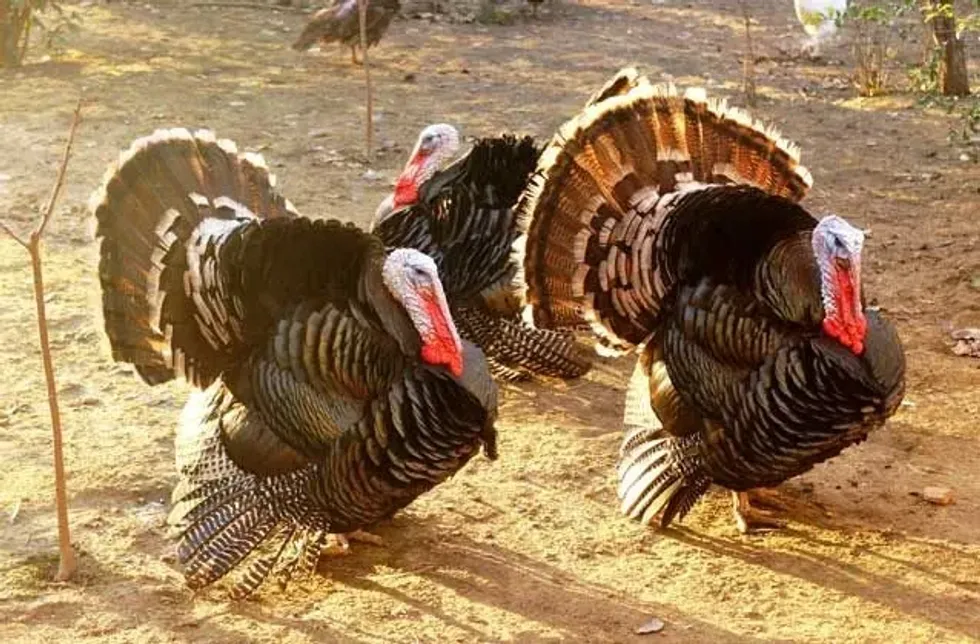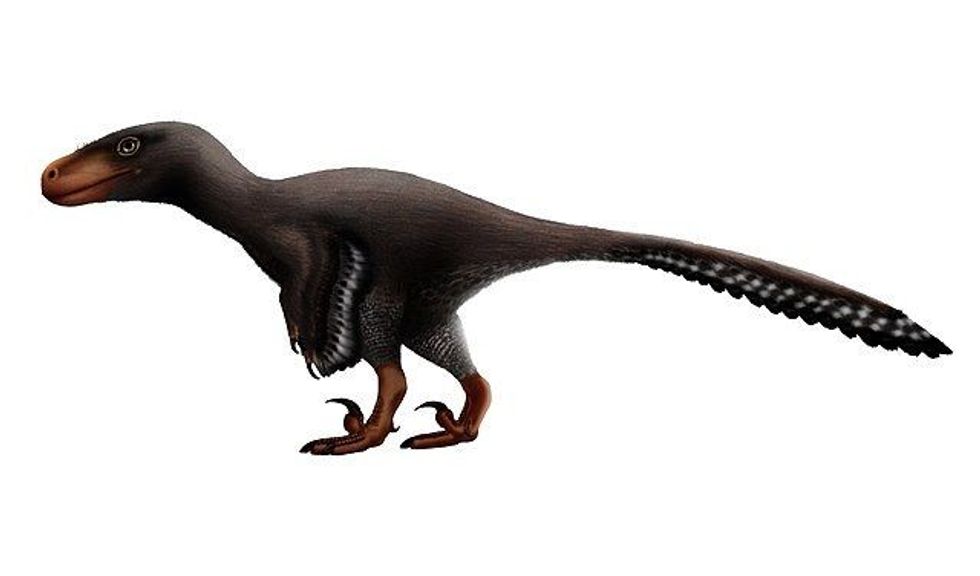Originally the domesticated breeds of the wild turkeys of the Native Americans, domestic turkeys are popular game birds. Wild and domestic turkeys share the same species and are essentially reared for their meat.
The breed that was native to the temperate regions of Mexican parts of America in the 16th century is presently abundant in every continent except for Antarctica. Though turkeys are non-native to Europe and Asia, the birds are bred extensively for their protein-rich meat, feathers, and eggs.
Turkeys are one of the most preferred main course servings, whether it is for Thanksgiving dinner or a get-together in the Christmas season.
One significant difference between wild turkeys and domestic turkeys is that domestic turkeys are broad-breasted, unlike wild turkeys. Both wild and domesticated turkeys come in a wide range of colors strewn all over their beautiful feathers.
Have you ever laid eyes on a turkey with white feathers? It'll soothe your senses!
Bird enthusiast or a foodie at heart, or maybe just looking for a pet prancing around your yard? Discover the amazing facts about domestic turkeys. Explore and share fascinating fun facts regarding the habitat, food habits, and other features of these domesticated birds.
If you enjoyed this fun-filled content about the domestic turkey, then feel free to take a quick glimpse at some interesting facts about the leghorn chicken and the lesser prairie chicken.
Domestic Turkey Interesting Facts
What type of animal is a Domestic Turkey?
Domestic turkeys are large poultry birds that share the same species as wild turkeys.
What class of animal does a Domestic Turkey belong to?
The domestic turkey belongs to the class Aves.
How many Domestic Turkeys are there in the world?
According to the available data, the number of turkeys was recorded at an average of 428 million in 2019. However, the accurate number of domestic turkeys in current existence cannot be ascertained as they are raised across innumerable farms across the world.
Where do Domestic Turkeys live?
Although the Native Americans solely bred these turkeys, they are now widely prevalent in almost every country (even in Asia and Europe). Their population spread rapidly throughout the temperate regions of the world owing to their profitable meat production.
What is a Domestic Turkey's habitat?
Once domesticated, the habitat of the turkeys got limited to outdoor spaces of farmlands where they are brought up under commercial environments. Both the wild and domestic variations require large open spaces.
Who do Domestic Turkeys live with?
These birds are raised in farmlands which implies that they live with the other flock members, in pairs, and sometimes with the other domesticated animals.
How long does a Domestic Turkey live?
Although both the wild and domestic turkeys are descendants of the same species, the former has a longer life span of about ten years. The longevity of a commercial turkey is cut short to one or two years as they are sold off and eventually slaughtered for their meat, feathers, or eggs.
How do they reproduce?
Generally, the breeding season commences in spring (February and March), but it largely depends on the climate and environment. Courtship involves strutting and gobbling of the males to please the females.
After the successful copulation, the females have an incubation period of 26 to 28 days. When reared in farmlands, the eggs are often removed from the hens and kept in incubators.
What is their conservation status?
Domestic turkeys are not listed under the International Union for Conservation of Nature (IUCN) Red List. These birds are pretty popular in the majority of countries around the world.
Domestic Turkey Fun Facts
What does Domestic Turkeys look like?

Since domestic turkeys are descendants of wild turkeys, they share a similar appearance. Both the wild and domestic turkey types exhibit glamorous shades with multiple colored feathers all over the body. The large-sized turkeys possess shades of brown, red, gray, bronze, black, and white. They have dark wings, fleshy wattles, and white-tipped tails.
How cute are they?
The cuteness quotient depends upon perspectives. However, these birds are adored for their beautiful plumage that comes in a variety of shades and colors. Apart from their delectable meat, these birds are also a treat to the eyes.
How do they communicate?
Turkeys express themselves through vocalizations. They are known to utter 28 significant calls, with each call bearing a distinct implication. The males are popular for their iconic gobbling sounds.
How big is a Domestic Turkey?
Approximately 46 in (117 cm) in length, a domestic turkey is larger in shape and size when compared with wild turkeys. They stand at an average height of 48 in (122 cm). They are much smaller than ostriches.
How fast can a Domestic Turkey move?
Although wild turkeys can fly short distances, domesticated turkeys cannot fly. Both wild and domestic breeds of turkeys can swim as well as run very fast.
How much does a Domestic Turkey weigh?
On average, the weight of domestic turkeys ranges from 30-40 lb (13.6-18.4 kg). However, the weight depends upon the variety. The royal palm turkey weighs around 16-22 lb (7.3-10 kg), while the Narragansett turkey weighs about 22-29 lb (10-13 kg) and the Broad Breasted White turkey approximately weighs 37-40 lb (17-18 kg).
What are the male and female names of the species?
A male domestic turkey is referred to as a gobbler or tom, while a female is called a hen.
What would you call a baby Domestic Turkey?
A baby turkey is popularly regarded as a poult.
What do they eat?
This breed is known to be omnivorous. Where the diet of wild turkeys comprises a variety of insects, lizards, vegetables, berries, and grains, the domestic turkeys raised by farmers are fed high-protein granulated food to add more pounds to the bird. In this case, the health of these birds is compromised in exchange for high-profit margins.
Are they dangerous?
The tamed turkeys generally possess a friendly nature. Once domesticated, they are not known to be aggressive. They are considered more social and approachable than the chickens.
Would they make a good pet?
Unlike a wild turkey, a tamed one can prove to be a decent pet, given that it is provided with proper space to stroll and move about. They cannot stay indoors and are best suited only for farmlands. They also need protection from predators like hawks, foxes, raccoons, bears, and others.
Did you know...
The National Wild Turkey Federation was established in the year 1973 to put a check on the hunting activities that are considered a potential threat to the wild turkey population. With members currently over 250,000, the National Wild Turkey Federation is still operational across multiple participating countries.
Even if most birds can fly at great speeds, domestic turkeys cannot fly, but they can run away quickly when chased.
Several turkeys grouping can be collectively called a muster or rafter but more commonly, a flock.
A season of celebration is incomplete without those extra pounds of a lip-smacking turkey platter. Almost 90% of American homes enjoy Thanksgiving by feasting on turkey.
Where did the first Domestic Turkey come from?
The history of domestic turkeys dates back 2000 years when the first variation of the domesticated breed is thought to have originated from the Mexican wild turkeys, developed by the Mayans native to the southern parts of Mexico. The Spanish explorers have been attributed the credits as they exported and spread these birds to Europe.
However, the European colonists brought back the birds to American grounds. The breed that was available solely in America spread rapidly throughout the entire world.
Will wild turkeys breed with domestics?
Although consummation between a wild and domestic turkey is not an impossibility, the chances are extremely thin. While the domestics are brought up in protected farmland enclosures, the wild is accustomed to the wilderness, thus reducing the possibilities.
Here at Kidadl, we have carefully created lots of interesting family-friendly animal facts for everyone to discover! Learn more about some other birds including turkey facts and ostrich facts.
You can even occupy yourself at home by coloring in one of our free printable domestic turkey coloring pages.










